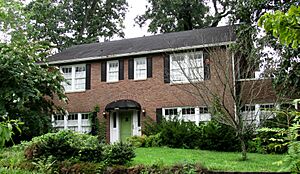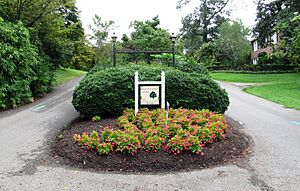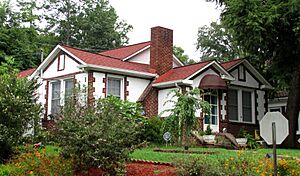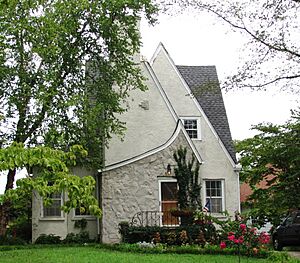North Hills Historic District (Knoxville) facts for kids
Quick facts for kids |
|
|
North Hills Historic District
|
|
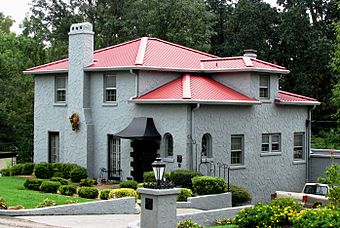
Spanish Eclectic-style house at 1829 North Hills Boulevard
|
|
| Lua error in Module:Location_map at line 420: attempt to index field 'wikibase' (a nil value). | |
| Location | Roughly bounded by North Hills Blvd., North Park Blvd., Fountain Park Blvd., Cecil Ave. Knoxville, Tennessee |
|---|---|
| Area | approximately 50 acres (20 ha) |
| Built | 1927–1958 |
| Architectural style | Colonial Revival, Tudor Revival, Spanish Colonial Revival, English Cottage Revival, Minimal Traditional, Ranch |
| MPS | Knoxville and Knox County MPS |
| NRHP reference No. | 08000677 |
| Added to NRHP | July 25, 2008 |
The North Hills Historic District is a cool neighborhood in north Knoxville, Tennessee, United States. It's a special place that was added to the National Register of Historic Places in 2008. This means it's recognized for its important history and unique buildings. The neighborhood started in 1927, created by the North Hills Corporation, to be a place where families could have custom-built homes. Today, the historic district includes 130 houses spread across about 50 acres. It's a great example of how homes and neighborhoods looked in the mid-20th century.
Where is North Hills Located?
The North Hills Historic District is about two miles northeast of downtown Knoxville. Imagine a map: Interstate 40 runs just south of it, and Broadway (U.S. Route 441) is just to the west. Washington Pike separates it from another area called Whittle Springs to the north. You can find the special houses in North Hills along streets like Abbey Road, Fountain Park Boulevard, Kenilworth Lane, Kennington Road, North Hills Boulevard, and North Park Boulevard.
The main "entrance" to North Hills is where Washington Pike meets North Hills Boulevard. Look for stone gateposts on each side with marble signs that say "North Hills." Some of the main streets, like North Hills Boulevard, North Park Boulevard, and Fountain Park Boulevard, are "true boulevards." This means they have a grassy area in the middle that divides the traffic lanes, making them extra pretty.
A Look Back: North Hills History
In the 1920s, more and more people started driving cars. This made it easier for families to live a bit further from the busy city center. So, many middle-class and wealthy people in Knoxville began moving to new neighborhoods designed for cars. This is when George Fieldan and his brothers, Hugh and Carl, started the North Hills Corporation. They wanted to create one of these new, car-friendly neighborhoods.
In 1927, the Fieldan brothers bought 43 acres of land. This land became North Hills Boulevard, Fountain Park Boulevard, and Kenilworth Lane. They started dividing the land into lots for houses. The very first house, located at 1929 North Hills Boulevard, was built that same year.
To make sure North Hills stayed a nice neighborhood, the North Hills Corporation put some rules in place in 1928. These rules said that the neighborhood was only for homes. They also set a minimum size for houses (at least six rooms) and a minimum cost for building them (at least $5,000 in 1928). The rules even specified what materials could be used for the outside of the houses and their roofs. All house designs had to be approved by the North Hills Corporation.
By 1933, 75 houses had been built in North Hills, and 175 lots were still available. Many early residents were doctors, lawyers, University of Tennessee professors, and people who worked for local companies or the Southern Railway. When the Tennessee Valley Authority (TVA) was created in 1933, it helped the neighborhood keep growing, even during the Great Depression. Many TVA employees bought lots and built homes there.
The Fieldan brothers continued to manage the North Hills Corporation into the 1950s. The neighborhood kept expanding during this time. The different styles of houses you see in North Hills are typical for the mid-20th century. The earliest houses (from the late 1920s) often had styles like Tudor Revival, Colonial Revival, and Spanish Colonial Revival. In the 1930s, English Cottage Revival and Minimal Traditional styles became popular. Minimal Traditional homes were still common in the 1940s. By the 1950s, many new houses in North Hills were Ranch-style houses.
Cool Houses in North Hills
The North Hills Historic District has 130 "contributing" houses. This means they are original to the historic period and add to the district's special character. There are also 28 "contributing" outbuildings, like garages and sheds. The district also includes special sites like the grassy medians in the boulevards, the street designs, and North Hills Park.
Here are a few examples of the interesting homes you can find:
- 2903 Fountain Park Boulevard: This is a one-story Craftsman-style house built in 1928.
- 2916 Fountain Park Boulevard: A two-story Colonial Revival-style house built around 1928.
- 1709 North Hills Boulevard: A one-story Minimal Traditional-style house built in 1935.
- 1714 North Hills Boulevard: A one-story Minimal Traditional-style house built in 1929.
- 1715 North Hills Boulevard: Another one-story Minimal Traditional-style house from 1929. Its outside walls are covered with beautiful East Tennessee marble.
- 1829 North Hills Boulevard: This two-story house, built in 1929, has a unique Spanish Eclectic-like design.
- 1905 North Hills Boulevard: A two-story Colonial Revival-style house built in 1929.
- 1906 North Hills Boulevard: A two-story Spanish Eclectic-style house, also built in 1929.
- 1920 North Hills Boulevard: Another two-story Colonial Revival-style house from 1929.
- 1928 North Hills Boulevard: A one-story English Cottage Revival-style house built around 1930. The bottom part of its front roof is covered in rough East Tennessee marble.
- 1929 North Hills Boulevard: This two-story Colonial Revival-style house was built in 1927, making it the oldest house in the North Hills Historic District!
- 2412 North Park Boulevard: A two-story English Cottage Revival-style house built in 1928.


